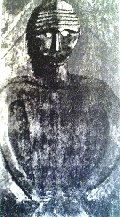Calling of the Spirits Posture
Home » Articles and News » Calling of the Spirits Posture
 by Paul Robear
by Paul Robear
The Calling of the Spirits Posture is one of the few that Dr. Felicitas Goodman categorized as a celebration posture. Her discovery of this posture is a story with an interesting twist, as recounted in her book Where Spirits Ride the Wind. After attending an event at The School of American Research in Santa Fe, she was given a guided tour of its private museum collection of American Indian art and artifacts.
“Always on the lookout for new postures” she writes, “I immediately noticed a male statuette in an unfamiliar stance. It was only about five inches high, made of yellowish clay with red-brick markings, and it stood on a small pedestal which carried the inscription, ‘Calling the Spirits.'” She had only time to jot down a brief description, and not the identifying code. She went back to find it, to no avail. The curators did an extensive search. It simply did not exist in the collections.
She did, however, find it widely distributed around the globe, and through time: “It seems to have been known in Europe from the Neolithic on, for instance in the Ukraine, and in more recent times in sub-Saharan Africa, in Melanesia, and especially in New Guinea. Most representations I have seen are from our hemisphere, however, starting from the Eskimos and going south all the way to Central America…. but to me, the most impressive artwork showing the posture is a Salish tamanus board from the late 1800s.(Image shown at the top of this article) Little is known about such boards; they were usually deposited at the shaman’s grave and left there to disintegrate. The intensity of the face has no peer. That shaman must have seen some pretty mightly Spirits.” See page 198-200 of Where Spirits Ride the Wind for the rest of her account of this posture.
 Instructions: This is a standing posture. Stand with your feet parallel, about six inches apart. As with all standing postures, the knees are slightly bent. Place your hands on your lower torso, right hand on right side, left hand on left side. Align the middle finger of each hand over the crease where the leg joins the torso, spreading your fingers widely, and lay them lightly on the body. Hold the upper arms away from the body. Close your eyes and tilt your head back slightly. Mouth is open, without any sound is traditional, however sound can also be added.
Instructions: This is a standing posture. Stand with your feet parallel, about six inches apart. As with all standing postures, the knees are slightly bent. Place your hands on your lower torso, right hand on right side, left hand on left side. Align the middle finger of each hand over the crease where the leg joins the torso, spreading your fingers widely, and lay them lightly on the body. Hold the upper arms away from the body. Close your eyes and tilt your head back slightly. Mouth is open, without any sound is traditional, however sound can also be added.
Home » Articles and News » Calling of the Spirits Posture
